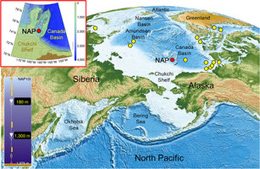Research Abstract
北極の海洋生物ポンプにおける活発化した渦活動の役割
Enhanced role of eddies in the Arctic marine biological pump
2014年5月27日 Nature Communications 5 : 3950 doi: 10.1038/ncomms4950

北極の海氷と海洋生態系は、気候科学者のみならず、経済ならびに政府機関においても関心が高い。しかしながら、広範囲での年間を通した生物地球化学の観測は欠落しており、このことが北極の海洋生物ポンプの複雑な変動を理解する上での障壁となっていた。本論文では、複数年にわたる係留観測と三次元数値モデル手法を用いて、西部北極海の生物由来粒子の沈降量が、初冬において最大となることを示し、陸棚縁で生じる渦が、大陸棚から隣接する深海盆にわたる生物ポンプに対して重要であることを明らかにした。本研究で捉えられた沈降粒子には、軟体部を残した新鮮な有機物を相当数含んでおり、沈降量はこれまでの見積もりよりも1桁大きかった。海氷のさらなる減少によって太平洋起源の生物種が北極海に流れ込み、北極海と亜寒帯海域をつなぐ物質循環が促進されることが予測される。
渡邉 英嗣1, 小野寺 丈尚太郎1, 原田 尚美1, 本多 牧生1, 木元 克典1, 菊地 隆1, 西野 茂人1, 松野 孝平2,3, 山口 篤3, 石田 明生1,4 & 岸 道郎1,3
- 海洋研究開発機構
- 国立極地研究所
- 北海道大学
- 常葉大学
The future conditions of Arctic sea ice and marine ecosystems are of interest not only to climate scientists, but also to economic and governmental bodies. However, the lack of widespread, year-long biogeochemical observations remains an obstacle to understanding the complicated variability of the Arctic marine biological pump. Here we show an early winter maximum of sinking biogenic flux in the western Arctic Ocean and illustrate the importance of shelf-break eddies to biological pumping from wide shelves to adjacent deep basins using a combination of year-long mooring observations and three-dimensional numerical modelling. The sinking flux trapped in the present study included considerable fresh organic material with soft tissues and was an order of magnitude larger than previous estimates. We predict that further reductions in sea ice will promote the entry of Pacific-origin biological species into the Arctic basin and accelerate biogeochemical cycles connecting the Arctic and subarctic oceans.

